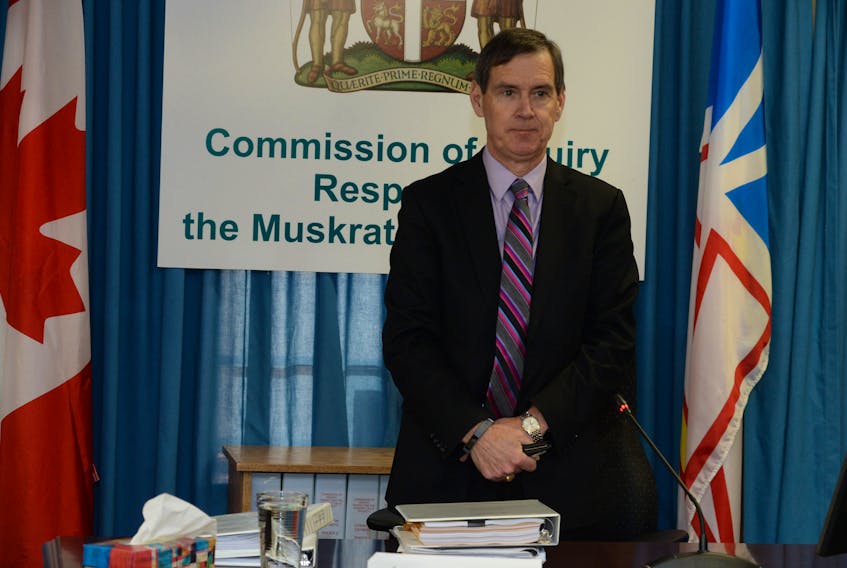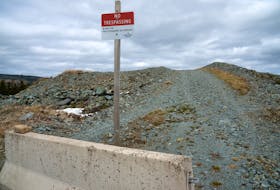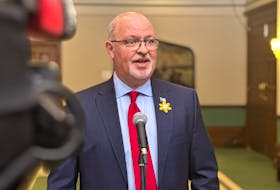The Muskrat Falls hydroelectric project on the Churchill River is publicly funded, years behind schedule and billions of dollars over budget.
In 2018, we marked the start of the Commission of Inquiry Respecting the Muskrat Falls Project — looking at exactly why the project was pursued, if it was really the best option for new power, and how the cost has reached $12.7 billion (including financing costs and added interest).

Proceedings have offered no shortage of new information and newsworthy moments, playing into the vote by readers to make it the News Story of the Year.
From an auditor’s report suggesting the hydro project may not have been the “least-cost” option, even when approved at just $6.2-billion (plus financing) in 2012, to the edits made to third-party reports before public release, there has been plenty to fuel ongoing analysis and public debate in Newfoundland and Labrador.
There was the moment the inquiry commissioner told the provincial energy corporation’s former CEO he was being “rude,” or the moment the same corporation’s chief financial officer said he felt pressured by a suggestion to complete project financing solely with the CIBC (the source of the suggestion is so far identified as being at the “ministerial or premier level,” as former CEO Ed Martin put it. Martin’s suggested the whole business is immaterial).

The heavy lifting is certainly still to come, as hearings continue in February 2019, and start to dig into the cost increases during construction.
The year that was
Looking back, the Terms of Reference for the Muskrat Falls Inquiry were issued in November 2017, when the inquiry was announced by Premier Dwight Ball.
Inquiry Commissioner Richard LeBlanc was quick off the mark. On New Year’s Day in 2018, as The Telegram reported, a lease for office space at the Beothuck Building in St. John’s kicked in. Work began in preparing the public hearing room, while the investigative efforts picked up under appointed inquiry co-counsel: Kate O’Brien and Barry Learmonth.

At the House of Assembly, at LeBlanc’s request, the provincial government took steps to assure sheriff’s officers were available for public hearings. An exemption for the inquiry under the province’s Access to Information and Protection of Privacy Act was also approved.
To smooth the road ahead, LeBlanc issued an interpretation of the terms of reference. He heard from individuals and organizations concerned with being able to pose questions to witnesses at upcoming hearings. He made determinations on these requests for standing.
The province placed estimates on the inquiry’s cost, budgeting $33.7 million over two years, including government’s own inquiry-related needs. Inquiry staff suggested a budget of about $25 million over two years to get to the final report.
With review of millions of individual documents and day after day of pre-hearing interviews with potential witnesses, hearings began at the Lawrence O’Brien Arts Centre in Happy Valley-Goose Bay on Sept. 17, with an invited, expert witness: Oxford University professor and researcher Bent Flyvbjerg. He spoke to hydroelectric dam costs around the world, testifying the only energy megaprojects riskier than hydro dams are nuclear power projects. Referring to a study of more than 270 dams globally, he noted “an average cost overrun of 96 per cent (median 32 per cent) and an average schedule overrun of 42 per cent (median 27 per cent).”
There was testimony on the political history of the Churchill River, and former premiers who had pursued a Churchill River development, while witnesses such as Innu Nation elder Sebastian Penunsi spoke to actual use of the area around Muskrat Falls and downstream.

As the hearings moved to St. John’s and the Beothuck Building, former premier Danny Williams — who many have described as the architect of the project — was called to the stand. Among other things, he hammered home his view a fair power deal could not have been reached with neighbouring utility Hydro-Québec, responding to auditors’ findings it was potentially abandoned prematurely as an option.
LeBlanc stepped in more than once as the hearings rolled on. He issued a reminder to lawyers and witnesses he was not able to settle ongoing disputes between Indigenous groups. He also declared he would not allow unproductive clashes between a collection of longtime project proponents (the so-called Muskrat Falls “cheerleaders”) and opponents (the “naysayers”), with the latter group including individuals asserting not all options were properly explored.
Line of witnesses
A line of current and former bureaucrats, Crown corporation employees and elected officials were questioned on their understanding of power alternatives and costs, including the risk for Muskrat Falls project overruns. Answers varied.

A disconnect was revealed between the understanding of some of the project team, versus Nalcor Energy’s former board of directors and the individuals within the government of the day.
“Cold eyes” reviews that had once given confidence to the public on project estimates were drawn into question. In some cases, individual reviewers offered far more explicit warnings of project risk while on the stand compared to in their written reports. In other cases, language that might have raised red flags on project risk in reports was watered down in suggested edits.
In the case of Manitoba Hydro International, a report recommending sanctioning was shown to have come from a “high-level” review of estimates, without any up-to-date review of risks. That approach was dictated by their government contract.
The arguments that some alternatives were not given full, public hearing have gained ground, for example as additional reports on natural gas came to light. The reports offered evidence of limitations in the information provided to the public before Muskrat Falls was approved.
Ed Martin was steadfast in his belief the project would benefit the province. He was called out by the Commissioner for his approach on the stand, but otherwise sailed through questioning with no questions on cross-examination from multiple parties including from lawyers for former premier Kathy Dunderdale, Nalcor Energy and the former board of directors.
Glenda Best (for the former board members) did suggest to Martin’s second, Gilbert Bennett, the board’s trust had been misplaced. But the inquiry has generally stuck to its fact-finding mission.
Some of the most important testimony came from Newfoundland Power president Peter Alteen, who suggested more investment could be required in the near future, beyond the bill on Muskrat Falls, to assure reliability on the main power grid in Newfoundland.
The final witness in the first phase of public hearings was former premier Dunderdale, who testified she still believes the project approved was the best choice at the time for Newfoundland and Labrador. She spoke in support of the public service and of Nalcor Energy, and wondered aloud at the tremendous cost increases — setting the stage for the work to come in the new year.
A final report from the inquiry is expected by the end of 2019.
Read our 2018 Muskrat Falls Inquiry coverage here.









